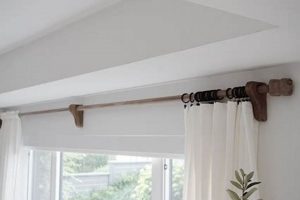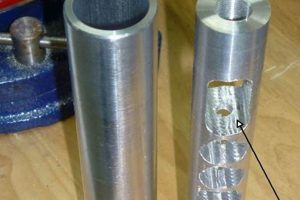A floral adornment, typically worn by men on the lapel of a suit or jacket, created through individual effort rather than purchased pre-made, offers a personalized touch to formal attire. As an example, consider the arrangement of a single rose, sprigs of greenery, and delicate filler flowers, carefully wired and taped together by the wearer to complement a wedding ensemble.
The creation of bespoke floral lapel decorations allows for cost savings, customized design choices, and the infusion of personal sentiment into special occasion wear. Historically, wearing small flower arrangements dates back centuries, evolving from functional purposes like masking odors to symbolic expressions of love, remembrance, and social status. This practice continues to provide opportunities for individual expression and creative exploration.
The following sections will delve into the selection of appropriate floral materials, the necessary tools and techniques for constructing these custom decorations, and considerations for ensuring their longevity and secure attachment to garments.
Essential Guidance
The following recommendations are intended to improve the process of crafting personalized floral lapel ornaments.
Tip 1: Floral Selection: Prioritize robust flower varieties, such as spray roses, carnations, or succulents, known for their resilience and ability to withstand handling. Delicate blooms may wilt prematurely.
Tip 2: Greenery Integration: Incorporate greenery like eucalyptus or ferns to provide structural support and visual contrast. Select types that are less prone to shedding leaves.
Tip 3: Wiring Technique: Employ floral wire to individually support each stem. Wrap the wire tightly around the stem and conceal it with floral tape for a clean appearance.
Tip 4: Taping Process: Use floral tape to bind all the stems together, creating a unified stem base. Stretch the tape as it is applied to activate its adhesive properties.
Tip 5: Securing the Fastener: Attach a boutonniere pin securely to the back of the stem base. Ensure the pin is adequately long and sharp to penetrate the fabric without causing damage.
Tip 6: Hydration Considerations: For extended wear, consider using a small water tube or floral preservative spray to maintain the freshness of the flowers.
Tip 7: Size Proportionality: Maintain a size appropriate to the wearer and the lapel; an oversized decoration may appear cumbersome. Limit the width to approximately two inches.
These measures promote both aesthetic appeal and prolonged freshness, resulting in a polished, enduring lapel adornment.
The subsequent sections will address the long-term preservation and stylistic variations applicable to these creations.
1. Flower selection
The selection of appropriate floral materials forms a foundational element in the successful creation of a custom lapel decoration. The chosen flowers directly influence the aesthetic appeal, durability, and overall longevity of the finished piece, impacting its suitability for the intended occasion.
- Durability Considerations
Certain flower varieties exhibit greater resilience to handling and environmental conditions. For example, carnations and spray roses possess a higher tolerance for temperature fluctuations and physical stress compared to more delicate options like sweet peas or gardenias. Selecting hardier blooms minimizes the risk of wilting or damage during the construction and wear of the decoration.
- Color Harmony and Complementary Elements
The color palette of the selected flowers should harmonize with the wearer’s attire and the overall event theme. Complementary greenery, such as eucalyptus or ferns, can enhance the visual impact of the flower arrangement. Careful consideration of color combinations ensures a cohesive and aesthetically pleasing design.
- Size and Scale Appropriateness
The size of the chosen flowers must be proportionate to the wearer’s lapel and body type. Overly large blooms can overwhelm the garment and detract from the overall appearance. Smaller, more compact flower varieties are often preferred for creating a balanced and refined aesthetic.
- Seasonal Availability and Cost
Flower selection should also take into account seasonal availability and cost factors. Choosing in-season blooms reduces expenses and ensures optimal freshness. Utilizing readily available and affordable options allows for cost-effective creation without compromising the overall quality of the adornment.
In conclusion, judicious flower selection significantly contributes to the success of the final product, dictating its durability, visual harmony, proportional balance, and overall cost-effectiveness. By carefully considering these aspects, creators can craft personalized lapel decorations that are both aesthetically pleasing and functionally appropriate for the intended occasion.
2. Wiring technique
The wiring technique is an indispensable component in the creation of a floral lapel decoration. Improper execution of wiring directly leads to structural instability within the floral arrangement, resulting in drooping flowers, separation of elements, and a compromised aesthetic presentation. For instance, stems not individually wired are prone to bending under their own weight, particularly in the absence of sufficient support. In contrast, the application of floral wire, carefully wrapped around individual stems and secured with floral tape, provides the necessary rigidity and support to maintain the desired form and orientation.
The choice of wire gauge and the method of attachment significantly impact the finished product. A wire gauge too thin may prove inadequate for supporting heavier blooms, whereas overly thick wire can be difficult to manipulate and conceal. A precise and methodical approach to wiring ensures that each floral element remains firmly in place, contributing to the overall coherence and durability of the floral lapel piece. Consider, for example, a multi-flower composition where individual stems, foliage, and filler flowers must be secured independently before being joined into a cohesive unit.
In summary, mastering the wiring technique is paramount for producing a visually appealing and structurally sound floral lapel piece. The effectiveness of the wiring process directly correlates to the stability, longevity, and overall success of the finished product. Challenges such as wire visibility and stem damage can be mitigated through careful application and the use of appropriate materials, underscoring the importance of this skill in the context of floral craftsmanship.
3. Taping Securement
Taping securement forms a critical step in the creation of custom floral lapel decorations, impacting the structural integrity and aesthetic appeal of the final product. Proper taping binds the individual elements into a cohesive unit, ensuring that the flowers, greenery, and other components remain securely in place throughout wear.
- Adhesive Selection
The choice of floral tape directly influences the effectiveness of the securement. Floral tape, possessing a slightly adhesive surface activated by stretching, is specifically designed for this purpose. Alternative tapes, lacking this adhesive quality, may fail to provide sufficient binding strength, leading to component slippage and a compromised appearance. The tape must exhibit sufficient tackiness without damaging delicate floral tissues.
- Wrapping Technique
The technique employed during the wrapping process significantly affects the strength of the bond. Taping should commence near the base of the flower heads, proceeding downward along the stems in a spiral fashion. Overlapping each layer ensures complete coverage and maximizes adhesion. Gaps or uneven wrapping can create weak points, increasing the risk of the arrangement falling apart during use.
- Concealment and Aesthetics
In addition to its functional role, taping contributes to the overall aesthetic of the piece. The floral tape should be concealed as much as possible to avoid detracting from the visual appeal of the flowers and greenery. Color-matched tape, blending seamlessly with the stems and foliage, is preferred. A neat and tidy taping job conveys professionalism and attention to detail.
- Moisture Resistance
Floral tape offers a degree of moisture resistance, helping to protect the stems from excessive water loss. This is particularly important for maintaining the freshness of the flowers over extended periods. However, taping alone is not sufficient to prevent wilting entirely; additional measures, such as hydration tubes or floral preservative sprays, may be necessary to prolong the life of the decoration.
Effective taping securement, therefore, integrates adhesive selection, proper wrapping technique, aesthetic considerations, and moisture resistance to yield a durable and visually pleasing floral lapel piece. The failure to adequately address these aspects can result in a fragile and unattractive final product, highlighting the integral nature of taping within the construction process.
4. Pin placement
Effective pin placement is paramount to the successful and secure attachment of a floral lapel decoration, directly influencing its presentation and the wearer’s comfort. Incorrect pin placement can lead to a variety of issues, including a drooping or misaligned decoration, damage to the garment fabric, or even the complete detachment of the adornment. The angle of the pin, its depth of penetration, and the chosen location on the lapel are all critical factors. For example, if the pin is inserted too high on the stem, the weight of the flower head can cause it to pivot forward, obscuring the wearer’s face. Conversely, if placed too low, the decoration may dangle precariously and become easily dislodged.
The ideal pin placement involves inserting the pin horizontally through the stem, close to the flower head, and then carefully maneuvering it through the lapel fabric, ensuring it emerges unseen on the underside. The pin should be positioned to support the bulk of the flower arrangement, distributing its weight evenly to prevent sagging. Additionally, the type of fabric dictates the appropriate pin gauge; delicate materials require finer pins to minimize the risk of tearing, while thicker fabrics can accommodate sturdier pins. Real-world scenarios, such as wedding photography or formal events involving movement, underscore the practical significance of secure pin placement, as a well-affixed boutonniere contributes to a polished and confident appearance.
In summary, pin placement represents a critical, often overlooked, element in the creation of a floral lapel decoration. Proper execution ensures the decoration remains securely and attractively positioned throughout its intended wear, while minimizing potential damage to the garment. The skill and attention dedicated to pin placement directly impact the overall success and presentation of the finished piece, solidifying its importance in the crafting process.
5. Greenery choice
Greenery selection significantly influences the aesthetic appeal, structural integrity, and overall thematic coherence of a custom-made floral lapel decoration. The incorporation of foliage introduces texture, color contrast, and visual depth, complementing the selected flowers and enhancing the overall design. The choice of greenery is therefore not merely decorative but also functional, contributing to the stability and longevity of the piece.
- Structural Support and Filler
Certain types of greenery provide structural support to the arrangement, acting as a framework for the more delicate floral components. Sturdy foliage, such as leather leaf fern or eucalyptus, can be used to create a foundation upon which the flowers are positioned and secured. Additionally, greenery serves as a filler, occupying space and creating visual fullness within the boutonniere. The appropriate use of greenery in this context prevents the arrangement from appearing sparse or incomplete.
- Color and Texture Contrast
Greenery offers a vital contrast in both color and texture to the selected blooms. Silver dollar eucalyptus, with its muted blue-green hue and rounded leaves, provides a subtle counterpoint to brightly colored flowers. Similarly, the feathery texture of asparagus fern contrasts sharply with the smooth petals of a rose, adding visual interest and tactile appeal. Careful consideration of color and texture ensures a balanced and harmonious composition.
- Thematic Consistency
The selection of greenery can reinforce the overall theme or style of the lapel decoration. For example, incorporating sprigs of evergreen foliage suggests a rustic or woodland aesthetic, while the inclusion of tropical leaves evokes a more exotic or contemporary feel. The chosen greenery should therefore align with the intended ambiance of the event or occasion for which the boutonniere is being created.
- Longevity and Durability
Certain types of greenery exhibit greater longevity and resistance to wilting than others. Selecting foliage that is known for its durability ensures that the lapel decoration maintains its freshness and visual appeal for an extended period. Leather leaf fern and eucalyptus are often preferred for their ability to withstand handling and environmental conditions without significant deterioration.
In conclusion, greenery selection is an integral aspect of creating a successful floral lapel decoration. The careful choice of foliage contributes to the structure, aesthetics, thematic consistency, and longevity of the piece, enhancing its overall impact and ensuring its suitability for the intended purpose. A considered approach to greenery selection elevates the custom floral piece from a simple adornment to a carefully crafted expression of persona
l style and occasion.
6. Size balance
Size balance constitutes a critical design element in the creation of personalized floral lapel decorations, directly impacting the aesthetic harmony and wearability of the finished piece. The relative dimensions of the floral arrangement in relation to the wearer’s lapel and overall physique determine its visual impact. An undersized embellishment may appear insignificant and lack presence, failing to effectively complement the attire. Conversely, an oversized creation risks overwhelming the wearer’s features and detracting from the overall formality or elegance of the occasion. Real-world examples illustrate this point: a large, multi-floral piece on a narrow lapel can appear cumbersome and unbalanced, while a small sprig on a broad lapel may seem lost or incomplete.
The principles of size balance extend beyond mere proportional matching to encompass considerations of floral density and projection. A densely packed arrangement, even within appropriate dimensions, can appear visually heavy and disrupt the line of the jacket. Similarly, a boutonniere that projects too far from the lapel may be susceptible to damage or detachment, compromising its intended effect. Practical application of this understanding requires careful consideration of the individual’s body type and the style of garment. For example, a taller individual with broader shoulders can generally accommodate a slightly larger arrangement, while a smaller individual is better suited to a more compact and understated design. Experimentation with different flower sizes and arrangements prior to final assembly allows for visual assessment and adjustments to achieve optimal balance.
In summary, size balance is integral to crafting a successful floral lapel decoration. Challenges in achieving balance stem from variations in lapel width, individual stature, and the inherent dimensions of floral materials. Overcoming these challenges requires careful observation, experimentation, and a commitment to creating an arrangement that enhances, rather than overwhelms, the wearer’s appearance. Ultimately, a well-balanced boutonniere reflects a nuanced understanding of design principles and contributes significantly to the overall aesthetic impact of the personalized floral creation.
7. Preservation methods
Effective preservation methods are critical to extending the lifespan and maintaining the aesthetic appeal of homemade floral lapel decorations. Given that these decorations are crafted from perishable organic materials, implementing appropriate preservation techniques is essential for mitigating wilting, discoloration, and overall deterioration, thereby ensuring the adornment remains presentable for its intended duration.
- Refrigeration Techniques
Refrigeration slows down the metabolic processes within the floral tissues, inhibiting bacterial growth and reducing water loss. Storing the finished decoration in a refrigerator, ideally within a sealed container or plastic bag, can significantly extend its freshness. The optimal temperature range is between 35F and 40F (2C and 4C). Direct contact with the refrigerator walls should be avoided to prevent freezing damage. This method is particularly effective for short-term preservation, typically lasting up to 24-48 hours.
- Humectant Application
The application of humectants, such as floral preservative sprays or glycerin solutions, helps to retain moisture within the floral tissues, combating dehydration and wilting. These substances draw moisture from the surrounding environment and bind it to the plant cells, maintaining turgor pressure and preventing desiccation. Floral preservative sprays often contain additional ingredients, such as biocides, to inhibit microbial growth. Regular application of a humectant can extend the lifespan of the decoration by several days.
- Desiccation Techniques
Desiccation, or drying, removes moisture from the floral tissues, effectively halting the decomposition process. Methods such as air drying, silica gel drying, or pressing can be employed to create a preserved floral lapel decoration that retains its shape and color for an extended period. Air drying involves hanging the decoration upside down in a cool, dry, and dark environment. Silica gel drying utilizes a granular desiccant to rapidly absorb moisture, preserving the flower’s three-dimensional form. Pressing involves flattening the flowers between absorbent materials, creating a two-dimensional keepsake. This technique is suitable for flowers with flat faces such as pansies.
- Stem Hydration
Providing a continuous source of hydration to the stems can significantly prolong the freshness. Small water tubes, specifically designed for floral arrangements, can be attached to the base of the decoration, allowing the stems to draw water and maintain turgidity. These tubes are discreet and do not detract from the overall appearance of the piece. Regular refilling of the water tubes is essential to ensure continuous hydration. This technique is especially valuable for decorations intended for extended wear, such as those used in weddings.
The effective implementation of preservation methods directly impacts the longevity and aesthetic appeal of custom floral lapel decorations. Combining multiple techniques, such as refrigeration coupled with humectant application or stem hydration, often yields the best results. The selection of appropriate preservation techniques should be guided by the specific floral materials used, the intended duration of wear, and the desired aesthetic outcome. These preservation efforts amplify the value and visual impact of personally crafted floral adornments.
Frequently Asked Questions
The subsequent questions address prevalent concerns regarding the creation of handmade floral lapel decorations.
Question 1: How does one prevent wilting of the floral elements within a handmade lapel piece?
Maintaining hydration is paramount. Employing floral preservative sprays or encasing stem ends within water-filled floral tubes can mitigate dehydration. Refrigeration prior to use also aids in preserving freshness.
Question 2: What constitutes an appropriate size for a floral lapel decoration?
Proportionality is key. The dimensions of the arrangement should complement the wearer’s lapel and physique. A decoration that is excessively large may overwhelm the garment, while one that is too small may appear insignificant.
Question 3: What type of adhesive is best suited for securing floral components?
Floral tape, which possesses inherent adhesive properties activated through stretching, is the preferred choice. Its moisture resistance and ability to bind stems effectively contribute to the structural integrity of the arrangement.
Question 4: How should a lapel pin be positioned to ensure secure attachment?
The pin should traverse the stem near the flower head, penetrating the fabric horizontally and emerging inconspicuously on the underside of the lapel. Proper pin placement distributes weight evenly and prevents sagging.
Question 5: What floral varieties exhibit the greatest resilience for use in handmade decorations?
Hardier species, such as spray roses, ca
rnations, and succulents, demonstrate superior durability compared to more delicate alternatives. These selections withstand handling and environmental stressors more effectively.
Question 6: How does one prevent the floral wire from becoming visible within the finished product?
Concealment is achieved through meticulous wrapping with floral tape. Overlapping each layer of tape ensures complete coverage and a seamless aesthetic, effectively masking the wire from view.
These considerations aid in the production of visually appealing and enduring lapel adornments.
The concluding section provides an overview of stylistic variations and advanced techniques applicable to these custom floral pieces.
Conclusion
This exploration of the diy boutonniere has illuminated the essential elements for successful creation, encompassing floral selection, wiring techniques, secure taping, precise pin placement, strategic greenery choice, balanced sizing, and effective preservation methods. Each facet contributes to the overall aesthetic and functional integrity of the finished piece. The mastery of these techniques allows for the creation of personalized adornments that reflect individual style and complement formal attire.
The act of crafting custom lapel decorations provides an opportunity to engage with time-honored floral traditions while exercising creative autonomy. Further exploration of advanced floral design principles and experimentation with unconventional materials will yield innovative and enduring results. Continued practice and a commitment to refinement will elevate the craft, ensuring the creation of bespoke floral pieces that enhance special occasions for years to come.







